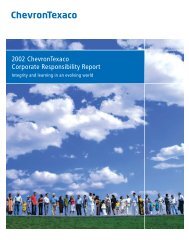Next* Magazine, Issue 5 - Chevron
Next* Magazine, Issue 5 - Chevron
Next* Magazine, Issue 5 - Chevron
Create successful ePaper yourself
Turn your PDF publications into a flip-book with our unique Google optimized e-Paper software.
PHOTOS: LEFT, MARILYN HULBERT; RIGHT, PAUL S. HOWELL<br />
<strong>Chevron</strong> consulting engineer and Petro’s chief architect,<br />
Ted Kutz (center), discusses methods for modeling gas-<br />
stream processing with planning analysts Ann Ciurczak and<br />
Nick Kenaston at the Richmond Technology Center.<br />
have a strong understanding of the<br />
manufacturing business.<br />
Petro’s Scenarios<br />
Factoring in market prices for product is<br />
important as well. “The market is dynamic<br />
for natural gas, gasoline and crude oil,” said<br />
analysis team leader Mark Davis. “Petro helps<br />
you shift your operations to capture the best<br />
economic point, whereas if you operated<br />
under an accepted paradigm, you’d miss<br />
opportunities or be slow to capture them.”<br />
Analysts also use Petro to see what happens<br />
when key variables change. Recently,<br />
Ted Kutz, <strong>Chevron</strong>’s refinery optimization<br />
expert and Petro’s chief architect, did just<br />
that. In a work session with California’s<br />
Air Resources Board staff, Kutz presented<br />
scenarios based on different fuel mixtures<br />
that the agency was considering for future<br />
regulations. He explained how certain<br />
fuel recipes could result in lower gasoline<br />
production and higher operating costs, which<br />
Petro processes 400 to 500<br />
variables associated with<br />
crude oil characterization,<br />
along with thousands<br />
of refinery-capability variables,<br />
and all within a few seconds.<br />
Traders—such as John Kuehn (left), general manager for crude trading in the<br />
Americas, and Freeman Shaheen, global manager for sour crude trading—<br />
provide market forecasts that planners import into Petro. Petro values are<br />
then compared with trading models.<br />
could lead to higher prices for consumers.<br />
Based on Petro’s report, Kutz showed how<br />
other formulations had less impact on supply<br />
and cost while meeting the board’s environmental<br />
targets.<br />
In the early days, one analyst would<br />
spend a half-hour setting up a question and<br />
wait two or three hours for a paper report<br />
an inch and a half thick. Only then could<br />
the analyst mull over the results. Now, the<br />
program is used by up to 200 people at<br />
once while processing as many as 10,000<br />
equations. And thanks to ever-increasing<br />
computing power, it takes only three minutes<br />
to set up a report and two or three seconds<br />
to see the results on screen. No longer data<br />
entry clerks, analysts now spend most of<br />
their time actually analyzing.<br />
There’s also an element of social<br />
networking to Petro. The ability to quickly<br />
share information has allowed for more<br />
collaboration.<br />
Ultimately, it’s the people who make<br />
Petro work. As a tool, Petro is only as good<br />
as the analysts who use it.<br />
Kutz used an analogy: “In boxing, a<br />
sparring partner helps train the boxer,<br />
and the same goes for Petro,” he said. When<br />
looking at a Petro report, “a good analyst<br />
will ask himself ‘Did Petro confirm my<br />
expectation? If not, why not?’” According<br />
to Kutz, “Petro supports the premise from<br />
a good analyst 80 to 90 percent of the time.<br />
But sometimes, nuances reveal something<br />
unexpected and point to a better course of<br />
action. It’s one way we’re using technology<br />
to differentiate <strong>Chevron</strong>’s performance.” ■<br />
<strong>Next*</strong> | 5

















